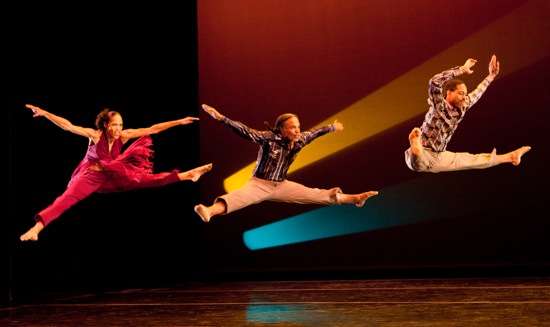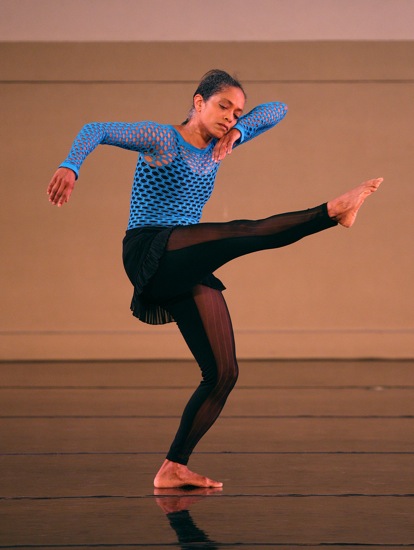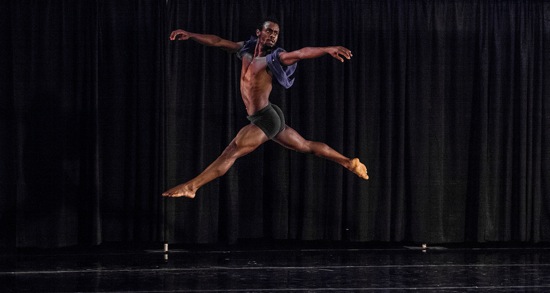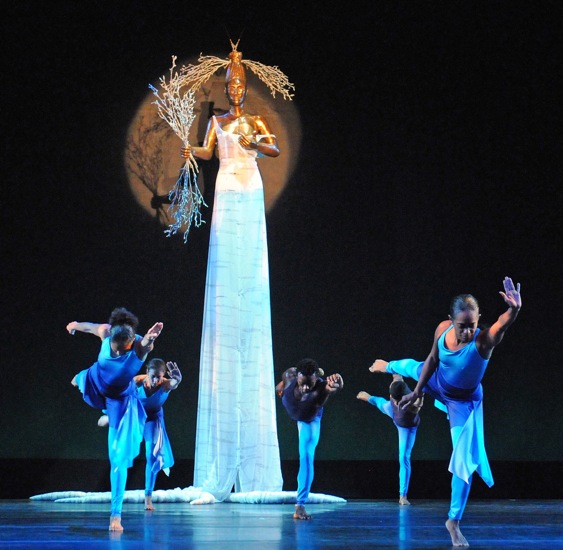Garth Fagan Dance brings two new works to the Joyce Theater, November 12 through 17.

Classic Fagan dancers (L to R): Nicolette Depass, Steve Humphrey, and Norwood Pennewell, as seen in
Garth Fagan’s 2010 Thanks Forty. Photo: Yi-Chun Wu.
Why is it that I always want to begin writing about Garth Fagan’s Rochester-based company by hymning the dancers? Maybe because he evidently feels the same way about them that I do. His Prelude (1981, revised 1983), which opens one of the group’s two programs at the Joyce, introduces them to us—old-timers and newcomers alike—as vibrant, dedicated members of a community, with killer physical skills. When the great Norwood Pennewell opens Prelude, you understand the piece’s subtitle: “Discipline is Freedom.” Here are the huge bounding jumps and leaps that appear without evident preparation—as if springs coiled inside each of the dancer’s legs had suddenly been released. Here are the very fast spins that chain across the stage; the long balances on the ball of one foot, while the other leg hovers somewhere high in the air; the spurts of rapid footsteps and their slow, sensuous opposite.
Prelude is not only an introduction to the dancers; it demonstrates how they train, as well as compiling a catalogue of the steps that—varied and deployed in many ways—appear in all the pieces that Fagan has designed for the company and the three that Pennewell has created since 2010. Fagan is one of the few choreographers working today whose style is immediately recognizable; if I came across dancers in a remote village in the Caucasus, say, or in Mozambique, doing certain movements, I’d ask, “When was Garth here?”
That’s not to deny that elements of modern dance, jazz, Caribbean, and African styles reside in the sub-strata of his choreography. But he shapes them to his personal dynamic, his ideas about structure and the practice of dance. You’d never want to apply the ballet term glissade to the speedy, lightly airborne side-step with which his dancers zoom across the stage. Fagan’s works are also shaped by his vision of community and how individuals within it relate. Reading the casting information for GFD’s Program A at the Joyce after I got home, I had to laugh. Various names may identify the leaders of a particular section of a dance, followed by “and Company.” But what you actually see goes beyond “stars” and “ensemble.” Under the rubric of “company,” solos pop up, trios form, people join in couples, five dancers decide to get together. Fagan is that anxious to show you how leaders emerge and easily rejoin the supposed followers.
Fagan’s company regime (a daily morning technique class and an evening one followed by a rehearsal) carves and disciplines both bodies and spirits and enlivens minds wisely (Steve Humphrey, an original member of the company, still spins his 61-year-old self through Prelude and Lighthouse/Lightning Rod). One of the pieces premiering at the Joyce is titled No Evidence of Failure. It honors the astonishing powerful and beautiful Natalie Rogers, who joined the company in 1989, left it in 2004 to raise a child, and re-joined it seven years later. Fifty-one? No sweat (not that we can see, anyway). Arching backward in a spotlight, lashing her arms around body, balancing, spinning, she’s a mistress of controlled dynamics. She can hit positions suddenly and hold them without a quaver, before releasing herself into an intricate flurry of footsteps. She can stand on one leg and rearrange her arms, torso, and head. She’s so sensitive to the phrasing of a selection from Monty Alexander’s Harlem-Kingston Express Live that the recorded applause might well be inspired by her.
When her partner, Vitolio Jeune, arrives on stage and starts running around, she’s standing where she ended her solo, one leg held waist-high in front of her, while she “sleeps,” one cheek on a lifted hand. Jeune comes up behind her and gently embraces her; she nestles against him, her leg still hung out to dry. Only when he lifts her, does her stance alter. As they back up toward a far corner to separate into separate but related passages of dancing, Rogers gives her partner a little kiss on the cheek. A sweet gesture and an acknowledgment of this terrific dancer, twenty years her junior.
Pennewell didn’t mean his new Gin to refer to the juniper-spiced liquor, but to the cotton gin invented by Eli Whitney in 1793. The machine, which winnowed out the seeds from the cotton, was labor-saving; on the other hand, the increased productivity also resulted in an expansion of slavery in the American South. After I saw the piece, I read that Pennewell had embedded in the piece several “focal points” that draw on and distill elements from a preceding section. I can’t say that I perceived this cotton-gin-related structure in the choreography, but however Pennewell used the idea, the outcome was a finely made piece.
As is Fagan’s frequent practice, Pennewell chose different pieces of music to accompany each of Gin’s four sections. Alarm Will Sound started the work with Aphex Twin’s “Blue Calx and a steady beat that sounds more like a stick hitting wood than a drumstick on skin. Yo-Yo Ma and three colleagues contributed “Quarter Dark Chicken” (remix by Douala); the spiritual “Calvary” provided the base for Coleridge-Taylor Perkinson’s Quartet No. 1; and Gin ended with Felix Laband’s “Donkey Rattle” (another Douala remix). Somehow they all work together.
What look somewhat like dark vines are intermittently projected across the back cyclorama, and at one point (for no reason that I can discern), Lutin Tanner’s lighting turns that background orange. Pennewell keeps the dancing at a controlled boil. Nearly all the nine dancers bubble out of it in fleeting solos, duets, and small groups. Rogers! Jeune! Roderick Calloway! Charity Metzger! Raven Jelks! Shannon Castle! Rogers dances slowly and smoothly, coming close to the front of the stage and giving us a bold stare. Behind her, Nicolette Depass and Wynton Rice begin their own adventure to Perkinson’s stringed-instruments exploration. During an earlier trio to “A Quarter Dark Chicken,” Anjue David starts jittering happily around, trying to get Jeune and Rice to join him. They stand there looking tired and exasperated until he gives up.
Watching excerpts from Fagan’s 2012 Lighthouse/Lightning Rod, you can see how Pennewell inherited his mentor’s way of moving individuals in and out of the group, or segmenting an ensemble into, say, a slew of trios, without losing the image of community. Both also insert bits of everyday human drama into a formal structure. For instance, a couple of times in this Fagan work, set to a score by Wynton Marsalis, Rogers and Sade Bully whirl through, hanging onto each other, sudden girlfriends sharing a confidence. Fagan and Pennewell also share a view of women as mostly strong and independent. The first half of Lighthouse/Lightning Rod’s title is represented by the towering statue of a woman (by Alison Saar), whose bronzed head, chest, and arms emerge from a yards-long skirt. People kneel down to this goddess, who presides over a blue-clad wave of dancers.
In one sequence of the work, the performers bend low and unfurl one arm, elbow first, to the sky. These marvelous dancers are Fagan’s lightning rods, pulling down inspiration into the rich soil of his work.



